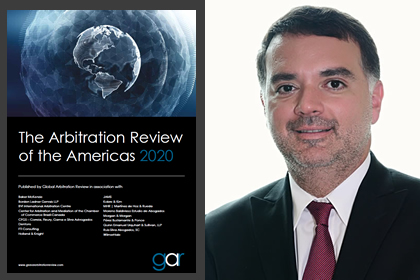Morgan & Morgan qualifies in IFLR1000 Financial and Corporate guide 2020
Morgan & Morgan received top-tier rankings in the international directory IFLR1000, a guide that analyzes the work of lawyers in the financial and corporate transactional area. In addition, five lawyers of the firm are listed as leading professionals: Aristides Anguizola – Rising Star Francisco Arias – Highly Regarded Carlos Ernesto González Ramírez – Highly Regarded
Morgan & Morgan featured in The Arbitration Review of the Americas 2020
Panama, November 6, 2019. Jose Carrizo, head of the Litigation and Dispute Resolution practice of Morgan & Morgan, contributed with the Panama chapter of The Arbitration Review of the Americas 2020, providing a comprehensive analysis of the arbitration system in Panama, its legislation and every aspect that confirms the country as an international and regional
- Published in 2019, Jose Carrizo, Litigation and Dispute Resolution_news, Press Room, Publications
Morgan & Morgan participated in The International Maritime Law Seminar 2019
London, October 3, 2019. Luis G. Raven, partner in the Shipping and Admiralty Litigation Department of Morgan & Morgan, participated in The International Maritime Law Seminar (IMLS), an annual event that takes place in the City of London and seeks to provide in-depth analysis and discussion of current legal topics critical to the marine industry.
- Published in 2019, Luis Raven, News, Shipping and Admiralty Litigation_news
Morgan & Morgan advised Avianca Holdings, S.A. in Exchange Offer of Senior Notes for US$550,000,000
Panama, November 1, 2019. Morgan & Morgan advised Avianca Holdings, S.A., a company incorporated under the laws of the Republic of Panama (the “Company”), in launch and consummation of an exchange offer of the Company’s previously issued US$550,000,000 8.375% Senior Notes due 2020 for newly issued US$550,000,000 8.375% Senior Secured Notes Due 2020 (the “Exchange
The importance of having a data-protection compliance program
Fanny Evans, Senior Associate, Morgan & Morgan In 2013, Virginia Ginni Rometty – CEO of IBM, said “I would like you to think of big data as the next natural resource that can be to our era what steam, electricity and oil were for the Industrial Age.” Probably, you have read or heard: Data is
- Published in 2019, Estate Planning_news, Fanny Evans, Probono, Publications, startups_resources
Market Intelligence Panama: Shipping 2019
- Published in 2019, Francisco Linares, Jazmina Rovi, News, Ship Finance and Registration_news
Morgan & Morgan featured in Market Intelligence-Shipping 2019
Panamá, October 29, 2019. Partners Jazmina Rovi and Francisco Linares contributed to the Panama chapter of Getting the Deal Through: Market Intelligence-Shipping 2019, a publication with an analysis of the evolution and the regulatory scenario of the maritime industry globally. To complete article can be read on the following link: Panama, Market Intelligence-Shipping.
- Published in 2019, Francisco Arias, Jazmina Rovi, Ship Finance and Registration_news
The Insolvency Law in Panama
Analissa Carles, Associate, Morgan & Morgan On May 19, 2016, the concept of a “Bankruptcy,” as the legal term was defined, ceased to exist under Panamanian law. Law 12 of 2016 (the “Insolvency Law”) entered into force on that date and introduced new proceedings into our legal system. These proceedings are referred to as Reorganization
- Published in 2019, Ana Carles, Litigation and Dispute Resolution_news, Press Room, Publications
New Law on tax amnesty in Panama: corporations and private interest foundations
Alvaro Tomas, partner and Vice President of Operations of the Fiduciary Unit of Morgan & Morgan The Panamanian government has issued Law 99 of October 11, 2019, which establishes a General Tax Amnesty Law (“Amnesty”) that includes the elimination, for a limited period, of the penalties and surcharges caused by non-payment of the obligations with
- Published in 2019, Alvaro Tomas, Estate Planning_news, Press Room, Publications
The ABC of the Tax Amnesty in Panama Law 99 of 2019
With this new legal initiative, the taxpayers have the opportunity to clear tax debts without interests, surcharges and fines and to file forms past due without penalties. Taxes included Those managed by the Revenues General Directorate What does the tax amnesty refer to? Condonation of: Interests Surcharges Fines Tax Amnesty Term If
- Published in 2019, amanda_barraza_publi, News, Taxation_news










